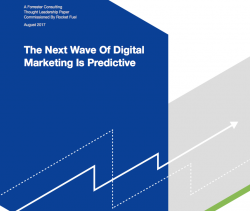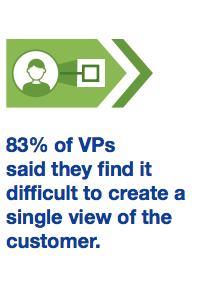With brand loyalty and customer attention more scarce than ever, Joel Christie reassures marketers scrambling to gain a competitive advantage, saying accuracy, insights and near-infinite numbers of new consumers are all within reach. If you are struggling to interpret reams of data to achieve personalisation, there’s a key to creating the single customer view – AI and the predictive marketer.
With the proliferation of devices and data, today’s marketers have an unprecedented opportunity to connect with consumers. Yet, at the same time, this presents a monumental challenge: what to do with all that data? Customers want immediate responses and relevant messaging, served in their channel of choice at a convenient time. If they don’t get it, they’ll go elsewhere – to your competitors.
Brand loyalty is fragile in a fragmented online world. So it’s up to marketers to use the oceans of data at their disposal to interact with people in the right way. As humans, we’re a fickle bunch and consumer empowerment through the likes of social media has made us even more ruthless at cutting ties with brands that don’t deliver.

Click here to view the research paper.
The predictive marketer: integration and consolidation
Marketers have the opportunity to collect, analyse and, most importantly, predict how to best engage with their customer with the next interaction – our research paper, which was compiled by Forrester, found that 84% want to create a marketing programme that learns and optimises from each interaction with a customer.
 Creating a single view of the customer is crucial in driving personalised and contextually relevant information, yet 63% of marketers say they find it difficult to personalise ads to individual customers because they lack insights and customer understanding.
Creating a single view of the customer is crucial in driving personalised and contextually relevant information, yet 63% of marketers say they find it difficult to personalise ads to individual customers because they lack insights and customer understanding.
What’s more, with data coming from a variety of sources, marketers are struggling to integrate it all – with two-thirds saying that customer and marketing data comes from too many sources to make sense of it. From various touch points to marketing campaigns or advertising platforms, there’s a lot to get your head round.
Merging and consolidating all this data is a challenge – and explains why creating a single customer view remains so difficult.
Action and speed
With access to deeper data than ever before, marketers are encouraged to gather, gather, gather, with very little knowledge or talk of what they will do with it all. Data without context is meaningless. Insights don’t glean themselves, so who will be tasked with sifting through it all to make sense of it?
Marketers are also struggling to turn this data and the insights it holds into action and the speed at which they need to do it seems to be particularly challenging: 65% of senior marketing decision-makers admit their customer insights team takes too long to deliver insights, and 62% said they are not able to use all their data when making customer decisions.
Predicting outcomes
Using AI means that tasks – such as organising and managing data as well as scouring it for insights – can now be completed in milliseconds. That sounds like a bold statement, but predictive capabilities transform marketing by looking at past behaviour to anticipate outcomes with a significant probability of accuracy before delivering personalised, relevant ads.
AI systems already enable marketers to develop predictive models. However, for these models to be powerful, they need to be supported by customer recognition, real-time insights and first-party data. It’s about optimising marketing campaigns based on predicted outcomes, rather than observed behaviours or outdated segmentation.
Case study

A predictive approach drives nearly 5k incremental bookings for Premier Inn.

Click here for more case study details.
With more than 750 hotels in the UK and 68,000 rooms, Premier Inn – owned by the Whitbread Group – was aiming to increase online bookings and raise awareness of the brand among consumers who had not previously visited its website. The company’s goals included:
- Increase leisure stay bookings
- Increase efficiency and scale from ad buying
- Raise brand awareness
We implemented an A/B prospecting test with Premier Inn, splitting the chain’s overall online audience into control and exposed groups. This allowed us to observe the impact of paid media on new customers, compared with a group that was not known to Premier Inn. Control audiences received display advertising encouraging them to donate to Great Ormond Street Hospital (Premier Inn’s nominated charity). Meanwhile, the exposed audience received strategic, dynamic, personalised creatives (DCO) showing nearby Premier Inn hotels based on customer profiles.
The hotel chain was able to distribute targeted creative to customers most likely to engage with the brand, reducing the chance of wasted or unwanted advertising and increasing the impact of the campaigns. Sizmek technology delivered a significant incremental conversion rate of 0.008%, which translated to 4,954 incremental conversions and £6.5 million in incremental revenue for the retailer. It also helped the brand improve the online customer experience.
Right place, right time
It’s something marketers once thought nearly impossible, but an ad can now be served through the channel expected to yield the best results, avoiding those customers who have a low probability of engaging. And, thanks to predictive technology, this is can be done instantly, at speed and scale.
AI-powered, predictive marketing is changing the way brands approach their activity, their analytics and the measurement of their results. Early adopters are already seeing the benefits of using predictive capabilities in marketing – 69% of marketers who have deployed predictive capabilities for at least two years said they were able to serve more relevant messages to consumers and improve personalisation. 57% said they were able to drive higher conversion rates as well as greater ROI for marketing activities. And 53% saw improved performance across the entire customer journey, ranging from brand awareness to conversions.
Consumers crave personalised experiences across devices, and marketers now have the tools to deliver it to them. As the expectations of consumers rise exponentially, and while brand loyalty is increasingly elusive, how will you keep up with your competitors over the next 12 months?
Have an opinion on this article? Please join in the discussion: the GMA is a community of data driven marketers and YOUR opinion counts.




 Creating a single view of the customer is crucial in driving personalised and contextually relevant information, yet 63% of marketers say they find it difficult to personalise ads to individual customers because they lack insights and customer understanding.
Creating a single view of the customer is crucial in driving personalised and contextually relevant information, yet 63% of marketers say they find it difficult to personalise ads to individual customers because they lack insights and customer understanding.




Leave your thoughts